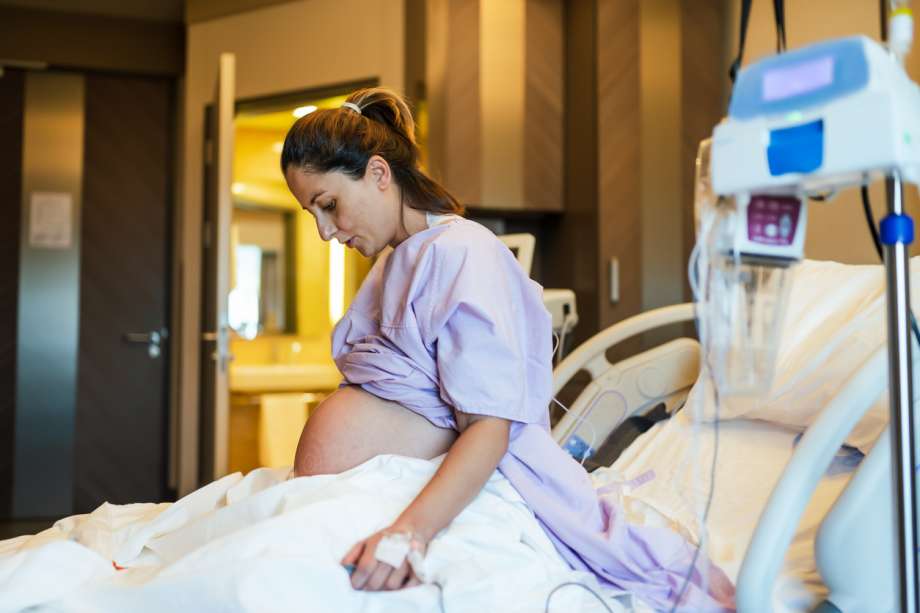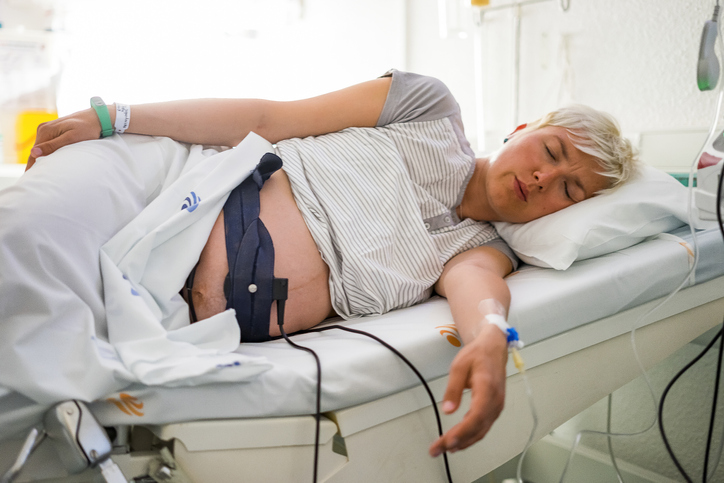Is the Dorsal Recumbent Position Used for Delivery?

During labor, pregnant women instinctively want to assume the best birthing position that allows for comfort, easy delivery of the baby, and ease of physical examination. The best position is usually dependent on a combination of factors; including if the baby is in a breech position, if the mother would prefer a vaginal delivery, and other peculiarities that an obstetrician may have picked up during the prenatal months.
What is the Dorsal Recumbent Position?
This is a position where the patient lies flat on their back and is asked to flex their hip and knee joints moderately while spreading them slightly outwards. In this position, the physician or the midwife can view the entire perineum during delivery, repair operations, and conduct vaginal examinations.
During vaginal delivery, this position helps the examiner to monitor vaginal dilation and the position of the baby’s head
What are the Different Positions for Labor and Birthing?

The birthing position is one of the practices influencing the successful outcome of labor and delivery, which is every pregnant woman’s desire. It refers to the physical position used by the pregnant mother during childbirth.
Different birthing positions can be broadly classified as either supine or upright, mainly based on the position of the woman’s vertebrae. Horizontal positions include the dorsal recumbent position (where the patient lies flat on their back), the semi-recumbent position (trunk tilted forward up to a 30° to the horizontal), the lithotomy position (where the patient lies flat on their back with both legs held up in stirrups), and the Trendelenburg’s position (where the head is lower than the pelvis).
In vertical postures, the body weight is off the sacrum, such as sitting (with an obstetric or birthing chair/stool), kneeling, squatting (unaided or with squatting bars/birth cushion), standing, and hands and knees positions.
These positions have their relative advantage or disadvantage in relation to the baby, the mother, or the clinician. For example, while horizontal patient positioning, such as the lithotomy and the dorsal recumbent positions, provide optimal perineal view for the clinician and allows for better access when an episiotomy is needed, it does make it more difficult and painful for the mother to push and could compress in the mother’s major vessels or cause nerve injury when sustained for long.
In contrast, upright positions are associated with better comfort for the mother and, with the assistance of delivery by gravity, better involvement of the participant's partner. Compared to supine positions, upright positions such as standing, kneeling, sitting, hands and knees, and squatting positions are associated with reduced duration of the second stage of labor, minimal report of severe pain, reduced rates of interventions such as episiotomies, a reduction in abnormal fetal heart rate patterns, and improved neonatal outcome.
The American College of Obstetrics and Gynaecologists also recommend upright postures, such as hands and knees, to resolve shoulder dystocia since this position has the broadest pelvic outlet. However, as reported by a study, these upright birthing positions carry a risk of greater postpartum blood loss of about 500mls and an increased risk of second-degree perineal tear.
Alternative positions include a lateral position, where the patient is asked to lie on one side of the body, the top leg in front of the bottom portion, hip and knee flexed. The Sim’s position is similar to the lateral position. However, the patient takes a posture that is midway between the lateral and prone postures.
What is the Best Position in the Second Stage of Labor?

The reality of the delivery room varies from patient to patient, and there are many factors to consider when the process begins. The mother, the baby, and any relevant medical professionals such as the midwife or gynecologist all have a stake in the direction of the birthing process. Medical professionals also want to monitor the baby frequently; therefore, they need access to the perineum; however, it is more important that the mother is comfortable and is empowered to deliver in the most convenient position.
As a result of all these factors and conditions associated with labor and delivery, it is impossible to pinpoint the best maternal position. Labor and delivery are a continuum that is associated with different conditions.
The current healthcare recommendation is to let the labor process dictate the best position. The mother should be allowed to assume different positions that her own physiologic realities require, as long as her health and that of the baby are not jeopardized.
How Do You Assume a Dorsal Recumbent Position?
First, you lie on your back and flex your thighs upwards at the hip joint at about 70°-80° while flexing your knee downwards at about 120°. Plant your feet in the bed. The thighs are rotated outwards to ensure complete visibility of the pelvic floor and the perineum.
This position is similar to but at the same time utterly different from the lithotomy position. Here, the hip and the knee are flexed at 90° while the legs are supported in the air by placing stirrups below the calf muscles.
Why Do people Use the Dorsal Recumbent Positions?
Although many teachings now recommend an upright maternal position during labor as much as possible, many still use the non-upright position. Reasons for this include;
- The convenience for healthcare workers
- Ease when carrying out fetal heart monitoring, even though this is not evidence-based
- When epidural analgesia is used, especially in high doses, it may lead to complete anesthesia of the pelvic and perineal nerves, which will limit the ability of the mother to stay upright
- Standards of training. Most caregivers and medical professionals were trained to assist with delivery while the mother was lying on her back.
- System formats: Most hospital systems are set up to take delivery in this position. And it has been shown in a recent randomized controlled trial that the birthing environment can determine the birthing position in the delivery room.
What are the Risks of Dorsal Recumbent Positions?

Due to the anatomic positions of the womb and other organs of the pregnant mother, the most apparent complication that may arrive from this position is the compression of her organs by the womb. The pressure on the inferior vena cava is most notable, which may lead to hypotension and decreased fetal oxygenation as there is low blood flow toward the placenta. This low blood flow may affect the baby’s skin color and pulse rate, contributing to a low APGAR score.
A mother that sleeps in this position often and for a prolonged period could also experience frequent constipation and heartburn.
It reduces the efficiency of uterine contraction, the size (diameter) of the pelvic outlet, and the mother’s push against gravity, all of which makes the birthing process more difficult. This difficulty in the birthing process makes assisted delivery necessary, either through episiotomy or forceps delivery, which could pose a health risk to the mother and the child.
What is the Difference Between Dorsal and Ventral Positions?
The difference is purely anatomic. For the Dorsal recumbent position, the patient is lying down on their back, while in a ventral recumbent position, the patient is lying down with their abdomen or towards the bed.
With the dorsal recumbent position, the entire weight is on the mother’s sacrum, which often leads to back pain. This pain is reduced and the likelihood of it occurring decreases by assuming the ventral position.
The dorsal recumbent position has seen continual use due to the high incidence of delivery through the cesarean section. However, it is essential to stress the importance of choice offered to the mother, designing the environment to conform to that choice, and the need for the healthcare providers to be trained to accept and manage these choices.

